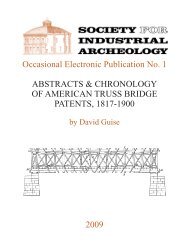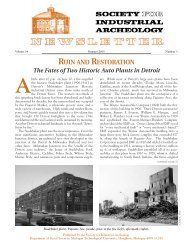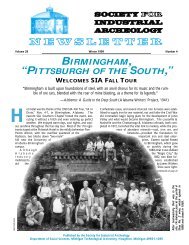RUHR, GERMANY - Society for Industrial Archeology
RUHR, GERMANY - Society for Industrial Archeology
RUHR, GERMANY - Society for Industrial Archeology
You also want an ePaper? Increase the reach of your titles
YUMPU automatically turns print PDFs into web optimized ePapers that Google loves.
REDISCOVERING L’ENFANT’S PATERSON<br />
The Paterson map of 1840 illustrates that some of L’Enfant’s street plan was adopted.<br />
Notice how a semi-octagon, labeled BCDEF, is <strong>for</strong>med by Paterson’s streets. Radiating from<br />
the octagon are five major streets River Street (r), Broadway (s), Market Street (t), Main<br />
Street (u) and Mill Street (v). The central point of L’Enfant’s city plan was the manufacturing<br />
center located within the semi-octagon where most of the mills were established in<br />
Paterson’s early years.<br />
W<br />
riting on the subject of beauty in 1903, Lucy<br />
Fitch Perkins, children’s book author and artist,<br />
asserted that, “No more inspiring document can<br />
be offered the student of Municipal Art than the<br />
history of the making of Washington.” Perkins<br />
was well aware that Pierre Charles L’Enfant was the Federal<br />
City’s architect. She did not know that he also created a city<br />
plan <strong>for</strong> Paterson, NJ.<br />
N o w, after two hundred years, L’ E n f a n t ’s city plan has been discovered<br />
beneath a muddled and unremarkable street plan superimposed<br />
over it by Peter Colt, who is remembered best <strong>for</strong> his role<br />
in the <strong>Society</strong> <strong>for</strong> the Encouragement of Useful Manufactures<br />
(S.U.M.), established in 1792. The S.U.M., guided by<br />
Alexander Hamilton, founded Paterson as a planned industrial<br />
community at the Great Falls of the Passaic River. Peter Colt is<br />
also known in relation to his nephew, Samuel Colt, who first<br />
manufactured legendary Colt revolvers in a mill on the S.U.M.’s<br />
g r o u n d s .<br />
<strong>Society</strong> <strong>for</strong> <strong>Industrial</strong> <strong>Archeology</strong> Newsletter, Vol. 30, No. 2, 2001<br />
Published accounts of the conflict<br />
between L’Enfant and Peter<br />
Colt have been confined to their<br />
different methods of bringing water<br />
to power the mills. Unpublished<br />
letters held by the Passaic County<br />
Historical <strong>Society</strong> also document<br />
that Colt’s ideas <strong>for</strong> a Paterson city<br />
plan vied with L’Enfant’s. Colt<br />
began superimposing his street plan<br />
over L’Enfant’s as early as 1793.<br />
Nevertheless, L’Enfant had already<br />
established a substantial component<br />
of a “spoked-wheel” city plan.<br />
Five of Paterson’s major streets radiate<br />
from an area below the Great<br />
Falls. The seven-and-a-half acre<br />
parcel that was the site of Colt’s<br />
mill and later Allied Te x t i l e<br />
Printing, is at its center (See SIAN<br />
Summer & Winter 1999).<br />
L’ E n f a n t ’s unpublished letters<br />
describe his plans <strong>for</strong> Paterson. He<br />
wrote on Aug. 19, 1792:<br />
Surrounded by high mountains as is<br />
the tract the <strong>Society</strong> has at disposal -<br />
I considered it was not material to<br />
observe a regular North & South and<br />
East & West direction <strong>for</strong> the streets[,]<br />
a method which I apprehend would<br />
rather be improper because it would<br />
end every street against steep mountain<br />
which would impede a free circulation<br />
of air. . . .<br />
L’Enfant’s city plan <strong>for</strong> Paterson<br />
considered the natural contours of<br />
the landscape and incorporated<br />
classical architectural principles. It<br />
was also very similar to L’Enfant’s<br />
now well known plan <strong>for</strong><br />
Washington. The Washington plan was also disregarded by<br />
subsequent builders, but unlike Paterson, late-19th-century city<br />
planners rediscovered and then championed L’ E n f a n t ’s<br />
Washington plan. It served as inspiration <strong>for</strong> the City Beautiful<br />
Movement in the nation’s capital.<br />
Alexander Hamilton wanted to make Paterson a model city<br />
of manufactories. Apparently, he brought L’Enfant to Paterson<br />
in 1792 to make it America’s second federal city. Of course,<br />
Paterson did not become America’s second federal city, but the<br />
legal and financial advantages that Hamilton gave it enabled it<br />
to become a great manufacturing center that excelled in the<br />
production of cotton, silk, locomotives, and aircraft engines.<br />
Today, after a century of industrial decline, Paterson struggles<br />
to maintain law and order, employment, and housing. Historic<br />
preservation was once seen as a potential economic boost but<br />
the results of more than 30 years of ef<strong>for</strong>t have not been inspiring.<br />
Abandoned mills and empty lots abound. A small mea-<br />
(continued on page 19)<br />
17






